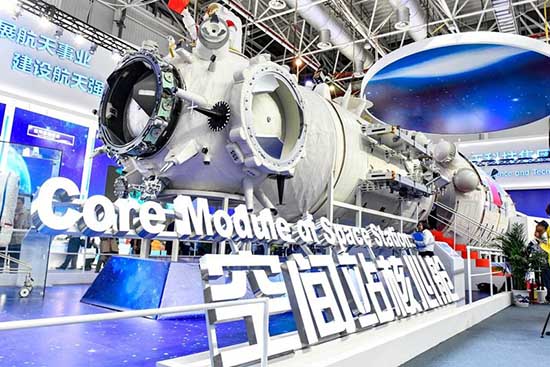2025年中國要在太空建發(fā)電站

|
中國探索宇宙的航天壯志正在飛向更高的軌道空間。 作為全球第二大經(jīng)濟(jì)體,中國一直在各方面努力提升自己的超級(jí)大國地位。繼成功完成舉世矚目的探索月球背面之旅后,中國正準(zhǔn)備在太空中建造一座太陽能發(fā)電站。中國航天項(xiàng)目的預(yù)算約為每年80億美元,在全球僅次于美國。可以看出,中國正在經(jīng)濟(jì)、軍事和科技領(lǐng)域與美國展開全方位的競爭。 目前,中國科學(xué)家已經(jīng)開始在重慶建設(shè)相關(guān)實(shí)驗(yàn)基地。據(jù)官方媒體《科技日?qǐng)?bào)》報(bào)道,中國的太空太陽能發(fā)電站計(jì)劃將分為幾個(gè)階段,起步階段是于2021年至2025年間在平流層建設(shè)一個(gè)小型發(fā)電站,第二階段是2030年前在太空建造一座1兆瓦級(jí)的太陽能發(fā)電站,此后的階段將陸續(xù)建造更多的空間發(fā)電設(shè)施。 那么,中國在航天領(lǐng)域已經(jīng)取得了哪些成就呢? 探月 2019年1月3日,中國航天人首次將一個(gè)月球探測(cè)器成功降落在月球背面,這一壯舉大大提振了中國航天事業(yè)的信心。由于月球背面不受地球電磁干擾,中國研發(fā)的嫦娥四號(hào)月球車能夠更好地對(duì)月球展開相關(guān)科研活動(dòng)。據(jù)中國官方媒體新華社報(bào)道,嫦娥四號(hào)搭載了一臺(tái)低頻射電頻譜儀,能幫助科學(xué)家了解“最早的恒星是如何被點(diǎn)燃的,以及我們的宇宙在大爆炸后是如何從黑暗中出現(xiàn)的。” 第一棵植物在月球上發(fā)芽 看過科幻電影《火星救援》(The Martian)的觀眾想必還記得馬特·達(dá)蒙在火星上種土豆的一幕。而在此次探月任務(wù)中,中國科學(xué)家也在測(cè)試荒涼的月球能否支持生命系統(tǒng)。據(jù)負(fù)責(zé)此次探月項(xiàng)目生物試驗(yàn)的重慶大學(xué)介紹,上個(gè)月嫦娥四號(hào)傳回的圖像顯示,在有關(guān)試驗(yàn)啟動(dòng)9天后,嫦娥四號(hào)帶去的棉花種子長出了第一枝嫩芽。此次嫦娥四號(hào)帶去的生物學(xué)試驗(yàn)載荷包括棉花、油菜、土豆、酵母和果蠅。 更多任務(wù) 下一步,中國還將繼續(xù)啟動(dòng)更多的探月任務(wù)。據(jù)中國國家航天局副局長吳艷華介紹,目前還有四個(gè)嫦娥探測(cè)器可能執(zhí)行登月任務(wù),其中至少兩個(gè)將在月球的南極著陸。中國國家航天局還將探索在月球表面建立科研基地。另外,中國很有可能在2020年前后啟動(dòng)火星探測(cè)任務(wù)。 空間站 中國計(jì)劃在2022年左右建成自己的空間站。該空間站被命名為“天宮”,它將由一個(gè)核心模塊和兩個(gè)用于科學(xué)實(shí)驗(yàn)的模塊組成,總重約66噸,能夠派駐三名宇航員,設(shè)計(jì)壽命至少為10年。該空間站將用于生物學(xué)、物理學(xué)和材料科學(xué)等十幾個(gè)領(lǐng)域的科學(xué)研究。 允許私營企業(yè)參與火箭研發(fā) 中國國家主席習(xí)近平放松了政府對(duì)航天發(fā)射的管制,未來,中國很有可能形成一批足以與埃隆·馬斯克的太空探索技術(shù)公司(Space Exploration Technologies Corp.)、杰夫·貝佐斯的藍(lán)色起源公司(Blue Origin)和理查德·布蘭森的維珍銀河公司(Virgin Galactic)相匹敵的本土小型航天公司。這些初創(chuàng)公司已經(jīng)獲得了中國的風(fēng)投資本和私募投資人的支持,同時(shí)也將能夠獲得中國航天項(xiàng)目專家的技術(shù)支持。 北斗 為了減少對(duì)美國掌控的GPS全球定位系統(tǒng)的依賴,中國耗資至少90億美元建設(shè)了自己的衛(wèi)星導(dǎo)航系統(tǒng)。眾所周知,GPS是目前全球使用最廣泛的定位系統(tǒng),大到軍用導(dǎo)彈,小到汽車、手機(jī)甚至你家寵物狗項(xiàng)圈里的芯片,使用的都是GPS的定位信號(hào),而GPS的所有衛(wèi)星都是由美國空軍控制的,這自然令中國政府感到不安。因此,中國獨(dú)立開發(fā)了北斗衛(wèi)星定位系統(tǒng),其定位精度能夠達(dá)到1米以內(nèi)。 太空垃圾 美國國防情報(bào)局本月表示,中國正在開發(fā)一些先進(jìn)的太空技術(shù),如“衛(wèi)星檢查與維修技術(shù)”和太空垃圾清理技術(shù)。該機(jī)構(gòu)稱:“至少其中的部分技術(shù)可作為針對(duì)美國衛(wèi)星的武器”。中國外交部對(duì)此回應(yīng)稱,美方的指責(zé)是“毫無依據(jù)的”。(財(cái)富中文網(wǎng)) 譯者:樸成奎 |
China’s space ambitions are shifting into a higher orbit. Following its successful and world-beating trip to the far side of the moon, China is preparing to build a solar power station in space, as the world’s No. 2 economy strives to burnish its superpower credentials. With an $8 billion annual budget for its space program, second only to the U.S., China is seeking to compete with its rival for economic, military and technological dominance. Scientists have already started construction of an experimental base in the western Chinese city Chongqing. Initially, they plan to develop a smaller power station in the stratosphere between 2021 and 2025, a 1 megawatt-level solar facility in space by 2030, and eventually larger generators, according to the state-backed Science and Technology Daily. Here’s what China’s been doing in space: Moon Exploration The nation’s space scientists successfully landed a lunar probe on the far side of the moon on Jan. 3, capping a series of missions and giving a boost to China’s ambitions. Landing on the unexplored region will enable Chang’e-4, the rover named after the mythical Moon Goddess, to better study the moon because of the lack of electromagnetic interference from Earth. The vehicle is equipped with a low-frequency radio spectrometer to help scientists understand “how the earliest stars were ignited and how our cosmos emerged from darkness after the Big Bang,” according to China’s official Xinhua News Agency. Green Shoots Reminiscent of the 2015 science fiction film “The Martian” starring Matt Damon, China’s lunar mission is also testing if the barren moon can support life. Pictures sent back from Chang’e-4 last month showed the first green leaf from cotton seeds nine days after the experiment was initiated, according to Chongqing University, which led the biological project. The test load on the mission carried cotton, canola, potato, yeast and fruit fly. More Missions China has more such missions in the pipeline. Four more versions of the Chang’e probe are in the offing, with at least two of them planned for a landing on the moon’s south pole, according to Wu Yanhua, vice administrator of the China National Space Administration. The agency will also explore setting up a research base on the moon. A Mars probe is likely by the end of this decade. Space Station China aims to build its own space station around 2022. Dubbed Tiangong, or Heavenly Palace, it will have a core module and two other modules for experiments, altogether weighing 66 tonnes and able to carry three people, with a designed life cycle of at least 10 years. The facility would be used for scientific research in a dozen areas including biology, physics and material sciences. Private Rockets President Xi Jinping has loosened the government’s monopoly on space launches, fueling the formation of small domestic companies with dreams of challenging companies such as Elon Musk’s Space Exploration Technologies Corp., Jeff Bezos’s Blue Origin and Richard Branson’s Virgin Galactic. The startups are receiving funding from China-based venture capitalists and private equity investors and can also rely on the expertise of rocket scientists from China’s space program. GPS Challenger Taking its rivalry with the U.S. to the heavens, China is spending at least $9 billion to build a navigation system and cut its dependence on the American-owned GPS — whose satellites beam location data used by smartphones, car navigation systems, the microchip in your dog’s neck and guided missiles. And, all those satellites are controlled by the U.S. Air Force, making the Chinese government uncomfortable. So, it has developed an alternative called the Beidou Navigation System, which eventually will provide positioning accuracies of 1 meter (3 feet) or less with use of a ground support system. Space Junk The Asian power is developing sophisticated space capabilities such as “satellite inspection and repair” and clearing up orbiting junk — “at least some of which could also function” as weapons against U.S. satellites, the U.S. Defense Intelligence Agency said this month. China’s Foreign Ministry has said the U.S. allegations were “groundless.” |













